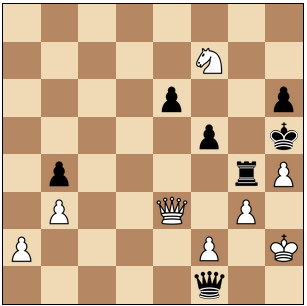FEN notation
From: https://github.com/tlehman/fenparser
Forsyth-Edwards Notation (FEN) describes a chess position. In a single line of ASCII text, it describes all the information about the state of a game.
FEN is based on a system created by Scotsman David Forsyth in the 19th century. Steven Edwards specified the FEN standard for computer chess applications as part of the Portable Game Notation.

The above position is described by the FEN string:8/5N2/4p2p/5p1k/1p4rP/1P2Q1P1/P4P1K/5q2 w - - 15 44
Breaking down our example FEN string a bit:
castling ability
| en passant target square
| |
| | fullmove counter
v v v
8/5N2/4p2p/5p1k/1p4rP/1P2Q1P1/P4P1K/5q2 w - - 15 44
| | ^ ^
------------------------------------- | L halfmove clock
|__ piece placement |
Side to move (white)This is the BNF grammar that describes the FEN notation:
<FEN> ::= <Piece Placement>
' ' <Side to move>
' ' <Castling ability>
' ' <En passant target square>
' ' <Halfmove clock>
' ' <Fullmove counter>
<Piece Placement> ::= <rank8>'/'<rank7>'/'<rank6>'/'<rank5>'/'<rank4>'/'<rank3>'/'<rank2>'/'<rank1>
<ranki> ::= [<digit17>]<piece> {[<digit17>]<piece>} [<digit17>] | '8'
<piece> ::= <white Piece> | <black Piece>
<digit17> ::= '1' | '2' | '3' | '4' | '5' | '6' | '7'
<white Piece> ::= 'P' | 'N' | 'B' | 'R' | 'Q' | 'K'
<black Piece> ::= 'p' | 'n' | 'b' | 'r' | 'q' | 'k'
<Side to move> ::= {'w' | 'b'}
<Castling ability> ::= '-' | ['K'] ['Q'] ['k'] ['q'] (1..4)
<En passant target square> ::= '-' | <epsquare>
<epsquare> ::= <fileLetter> <eprank>
<fileLetter> ::= 'a' | 'b' | 'c' | 'd' | 'e' | 'f' | 'g' | 'h'
<eprank> ::= '3' | '6'
<Halfmove Clock> ::= <digit> {<digit>}
<digit> ::= '0' | '1' | '2' | '3' | '4' | '5' | '6' | '7' | '8' | '9'
References
- Standard: Portable Game Notation Specification and Implementation Guide
- Forsyth-Edwards Notation from Wikipedia
- https://www.chessprogramming.org/Forsyth-Edwards_Notation
- Chess Programming – Chess Board Implementation : A FEN parser